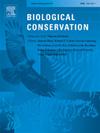Conservation translocation immediately reverses decline in imperiled sage-grouse populations
IF 4.9
1区 环境科学与生态学
Q1 BIODIVERSITY CONSERVATION
引用次数: 0
Abstract
Conservation translocation (hereafter translocation), the intentional movement of organisms from one location to another as a management tool, can be an extremely useful conservation action to increase the abundance of isolated populations following successful habitat restoration. However, managers seek to weigh the benefits against costs to the source population from which individuals are removed. Using two small and imperiled greater sage-grouse (Centrocercus urophasianus; hereafter sage-grouse) populations, we demonstrated the usefulness of translocation as a conservation management tool and the value of evaluating the potential consequences of translocation action. Using integrated population models and a before-after-control-impact (BACI) design, we quantified the extent to which translocation influenced the finite rate of change () of apparent abundance () in both reinforced and source populations. We also assessed changes in underlying demographic rates in one population, allowing for identification of the specific mechanisms causing differences in population trends following translocation. In both reinforced populations, substantially increased following translocation. In the population for which we had sufficient demographic data, the increase in resulted from a 179 % increase in egg hatchability following reinforcement. In one translocation, we did not observe adverse effects on the source populations. The source population for the second translocation exhibited reduced population growth rates after translocation, although BACI ratios indicated causes for population declines independent of translocation effects, highlighting the need to investigate processes together with observed patterns. Overall, we demonstrated the ability to rescue isolated sage-grouse populations via translocation, preserving population viability and metapopulation persistence.
求助全文
约1分钟内获得全文
求助全文
来源期刊

Biological Conservation
环境科学-环境科学
CiteScore
10.20
自引率
3.40%
发文量
295
审稿时长
61 days
期刊介绍:
Biological Conservation is an international leading journal in the discipline of conservation biology. The journal publishes articles spanning a diverse range of fields that contribute to the biological, sociological, and economic dimensions of conservation and natural resource management. The primary aim of Biological Conservation is the publication of high-quality papers that advance the science and practice of conservation, or which demonstrate the application of conservation principles for natural resource management and policy. Therefore it will be of interest to a broad international readership.
 求助内容:
求助内容: 应助结果提醒方式:
应助结果提醒方式:


